|
FIELDWORK
Egypt's
own most famous
Egyptologist, Dr. Zahi
Hawass, once estimated
that 70 percent of his
country's ancient
treasures remain to be
discovered.
Before
sites and objects can be
studied, they must first
be found. A major focus of
21st-Century Egyptology is
defining new sites and
establishing accurate
boundaries for well-known
sites, as well as
restudying sites cursorily
studied in past centuries,
by using new technologies.
Hundreds
of years ago, the emphasis
was on treasure hunting
and trophy collection,
often with no detailed
mapping or recording of
provenance.
Today,
the most careful and
exacting measurements and
documentation are
performed in the field,
according to established
scientific protocols.
Goals include:
|
|
|
| 1. |
Determining
the boundaries of
settlements. |
| 2. |
Establishing
the hidden foundations of
walls, dwellings, temple
precincts, and storage
structures. |
| 3. |
Determining
the extent of cemeteries
or animal husbandry areas.
|
| 4. |
Finding
the footprint of ancient
harbors and quays. |
| 5. |
Determining
the usage of specific
buildings or
neighborhoods: i.e.
barracks, brewery, grain
storage, etc. |
It is within or
adjacent to these ancient
structures, that artifacts
themselves are found and their
context analyzed.
|
Excavation
Planning
To commence field
study in an organized
manner and to utilize
expedition funds
effectively,
archaeologists will
often perform surveys
over a large swath of
land in order to
systematically
document features that
are visible to the
naked eye and collect
and analyze artifacts
that are lying on the
surface.
Archaeologists may
also excavate sample
(or "test") trenches,
or take deep core
samples of soil, and
then analyze the
results prior to
deciding upon a
particular excavation
site. Surveys and
samples are economical
and ethical ways of
learning about a large
site without having to
excavate it
completely.
|
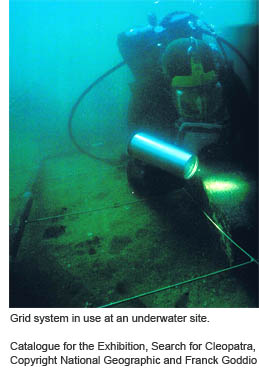 |
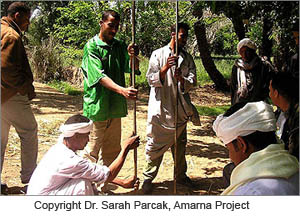 |
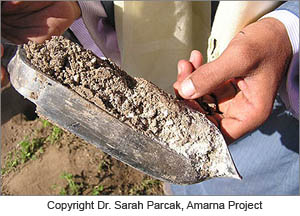 |
| Core
sampling at an
excavation site. |
Stratigraphy
Archaeologists working in Egypt
utilize numerous techniques to
understand the soil features and
artifacts that they uncover. One
of the most basic techniques is
studying the stratigraphy, or the
horizontal layers ("strata" or
"contexts"), that make up an
archaeological unit (a "square" or
"trench"). Looking closely at the
strata visible in the course of
excavation, including those
apparent along the edges, or
profile, of a unit, helps
archaeologists to understand the
past natural and human activities
at a site.
Ceramic
Analysis
Another indispensible tool is
ceramic analysis. Since pottery
produced in Egypt changed in form,
material and decoration over time,
archaeologists are often able to
date their strata using pot sherds
uncovered there. For example, a
particular type of blue-painted
pottery from ancient Egypt was
only manufactured between the
mid-18th and mid-20th Dynasties.
Thus, the appearance of a sherd of
blue-painted ware in an excavation
can date a stratum to that period.
The current standard for ceramic
analysis is the Vienna System, an
internationally recognized schema
for classifying Egyptian pottery.
Seriation
The relative dating technique
called seriation (or "sequence
dating"), whereby objects are
placed in chronological order
according to changes in their
shape and decoration, was
developed by William Matthew
Flinders Petrie, the "Father of
Egyptian Archaeology", while
excavating Predynastic burials at
the site of Diospolis Parva (Hu)
in the late 19th century. The
technique can be used to date
ceramics as well as other types of
artifacts that display changes
over time, such as stone tools.
Seriation is especially useful
when scientific (i.e. carbon-14)
or stratigraphic dating is not
possible.
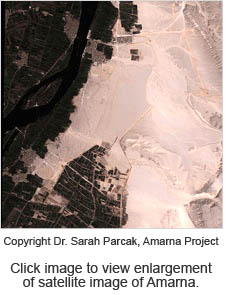 New
Technologies New
Technologies
Archaeologists are always making
use of new technologies to aid in
their research. Today,
archaeologists may incorporate
into their work technologies such
remote sensing and satellite
archaeology, Geographic
Information Systems (GIS), 3D
laser scanning and visualization,
X-ray flourescence (XRF), mass
spectrometry, and neutron
activation analysis (NAA).
Digital
Humanities
Digital Humanities (also known as
Humanities Computing) is a
fast-growing research area in
which scholars combine methods
from the humanities, computer
technology, and digital publishing
in order to ask new questions of
data and produce new, digital
outcomes. Egyptologists are
increasingly utilizing tools like
data mining and visualization,
Geographic Information Systems
(GIS), and extensive metadata to
augment and enhance our knowledge
of ancient Egypt and trace the
history of the field. Examples of
Egyptological Digital Humanities
projects include online resources
such as American
Egyptomania, Digital
Karnak, and the Giza
Archives, Sarah Parcack's
use of satellite
archaeology in Egypt, and
open access publications such as
the UCLA
Encyclopedia of Egyptology.
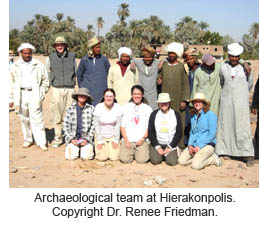 Archaeological
Teams Archaeological
Teams
Archaeological teams are
frequently composed of a group of
students and specialists from a
variety of fields, from
classically trained Egyptologists
and archaeologists to architects,
art historians, bioarchaeologists,
ceramicists, chemists,
conservators, engineers,
epigraphers, geologists,
photographers, surveyors, and
others. Archaeological teams are
typically diverse, international
teams with members from Egypt and
around the world. Archaeological
fieldwork is truly collaborative,
and the results are featured in
websites, blogs, magazines,
journals, and books in a wide
variety of languages.
 Field
Schools Field
Schools
Archaeological field schools help
to train archaeologists and
conservators of the future. You
can read more about ARCE-sponsored
expeditions and field schools here.
|